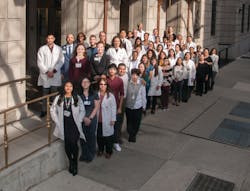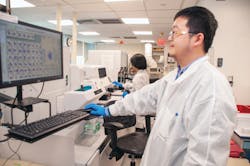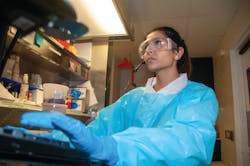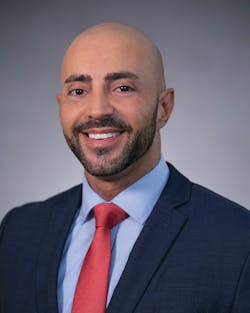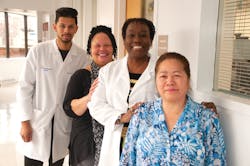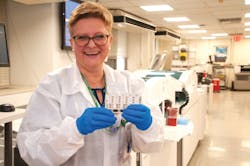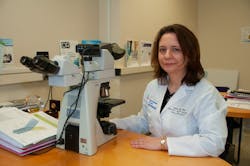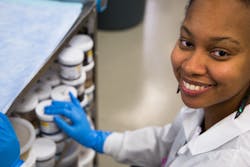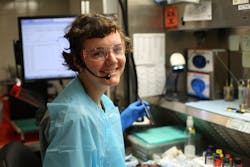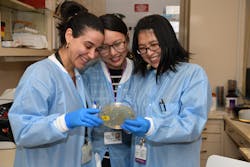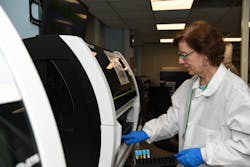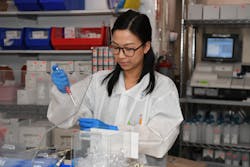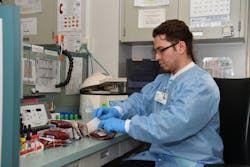2020 MLO Lab of the Year: Lenox Hill Hospital - the lab dedicated to above and beyond in all areas
Located in New York City’s prestigious Upper East Side, Lenox Hill Hospital opened its doors to the community in 1865 and continues to serve approximately 325,000 patients per year through those same doors. Earning its reputation over the years as a teaching hospital, the 632-bed Lenox Hill Hospital has provided care to both celebrity and layperson alike, with the same attention to treating a wide range of medical conditions and diseases.
Dedicated in its support of the hospital’s medical staff is the Department of Pathology and Laboratory Medicine, which is located on the 11th and 12th floors of Lenox Hill Hospital’s main building. It’s here you’ll find anatomic and clinical pathology labs, as well as research labs, along with anatomic pathology offices, point-of-care (POC) offices and a blood bank. On these two floors, almost 200 team members take part in processing 1,500,000 samples per year from in-patient and outreach clients, as well as from eye, ear, throat and retroviral clinics.
Customer Service
An example of customer service being improved was a concern about communication between phlebotomists and physicians that was handled proactively. Using the survey, some clinical providers indicated that the causes of unsuccessful venipunctures are often not communicated to them, which can delay patient treatment and discharge. To address and overcome this issue, a standardized template with a drop-down menu was added to the Laboratory Information System (LIS) so phlebotomists can choose the reason a venipuncture may have been cancelled.
Since the survey was implemented in 2017, the lab’s customer satisfaction has increased each year. In 2019, the majority of respondents (>80 percent) gave the lab an excellent rating.
Beginning in 2018, the lab also initiated a collaboration with physicians through meetings with the Department of Medicine. According to the lab, the “Laboratory Meets Medicine” meetings looked to “identify opportunities to improve patient care through proper utilization of lab resources, and by connecting lab leadership, hospitalists and residents.”
In addition to the meetings, other successful aspects of the lab-physician collaboration were the elimination of the 2 a.m. blood draws, enhanced attention to blood culture fill volume and proper collection of samples.
Productivity
When it comes to increasing productivity, the Department of Pathology and Laboratory Medicine has looked to overcome the challenge facing labs nationwide – that being a shortage of medical technologists.
Tajana Turato, MS, MLS (ASCP)cm, Laboratory Operations Manager, Clinical Pathology, said, “In the microbiology laboratory, we took advantage of the latest available technology and coupled it with creative workflows to produce a significant impact on patient throughput.”
She cited adoption of testing platforms that made the testing available 24/7, reduced the turnaround time by one hour and facilitated timely triage and throughput in the emergency room. She also pointed out that implementation of MALDI-TOF MS and a blood culture identification multiplex PCR panel reduced the bacterial identification turnaround time by 48 hours which, coupled with strong partnership with the antibiotic stewardship committee, ensured that targeted antibiotic treatment is administered to the patients sooner.
Cost savings is evident in the Blood Bank department where a strong Patient Blood Management program exists, as well as several initiatives to decrease blood waste. The Blood Bank also coordinates four blood drives each year, which is another way they contribute back to the community and their patients, as the blood bank team works around the clock to provide blood to patients in need.
In Anatomic Pathology, Advanced Barcoding & Tracking is available to provide accurate patient identification, as well as locating a specific pathology case at any time. This increases efficiency by eliminating wasted time spent searching for a case. In Cytopathology, they have increased their outreach program to promote healthy gynecological screening solutions by implementing PAP smear testing, with their volumes skyrocketing over the last year and still increasing.
Teamwork
The Clinical Pathology Laboratory at Lenox Hill Hospital places great importance on teamwork, both in and outside the department. As such, one of their recent teamwork accolades was an award nomination for a low-cost alarm system that is used to alert the team that a lactic acid sample has been delivered to the lab and is ready to be tested.
The idea for the alarm system came about because “when a lactic acid sample is delivered to the laboratory, the accessioner will vocally alert the technologists that the sample is pending. This workflow has been followed for some time, but it has posed a challenge during the evening and night shifts when a reduced number of staff is present and they may not necessarily be able to hear the announcement or attend to the sample right away,” explained Turato.
She added that even though the team was consistently meeting the turnaround-time and delivering results within 30 minutes, the suboptimal workflow caused frustration among the team.
Turato continued, “Because of audible limitations and to make the notification protocol easier when there is a reduced number of staff present, a member of our evening team came up with the idea of installing a wireless bell and light system. With this setup, the accessioner has to only drop off the sample by the analyzer and press the bell and a light button. A bell positioned right next to the technologist will produce an auditory and visual cue that they can see and hear. The bell and the light will not go off until they are manually turned off by the technologist, when he/she acknowledges the receipt of the new sample.”
This alarm system consists of a portable doorbell with a light remote control and a DOT-it LED light, which was donated by a team member. The lighting unit was outfitted with red-colored gel to increase visibility. Both the remote control and LED light were mounted on an acrylic plate, custom built by another team member.
“This simple solution cost only $30 but had an immense impact on the team morale, as well as patient care,” reported Turato.
Education and Training
The education and training options that are offered at the Clinical Pathology Laboratory at Lenox Hill Hospital are arguably equal to some college programs in duration and just as in-depth.
Pierre Mouawad, MBA, MLS, PI Process Manager, explains, “Our laboratory is renowned for the education and training that we provide. First, we have a very strong residency program where residents rotate for four years in Anatomic and Clinical Pathology, and recently we instituted a Surgical Pathology fellowship program as well. We are also a hub for medical laboratory technology students who come from all over the five boroughs of New York City. Those students rotate in all areas of the lab, shadow managers and supervisors, and spend a whole week with the quality manager learning about quality management, policies and procedures, CAP and state inspections, proficiency testing, data analysis and process improvement.”
The high school students take a tour in every laboratory with an explanation of what happens inside each lab and they ask lots of questions. Some high school students spend a few hours, some stay a few weeks, and some even spend the whole summer in the laboratory and they rotate through several areas including quality management or their chosen area.
Mouawad continues, “Since we know about the shortage of medical laboratory technologists across the nation, we wanted to influence high school students to visit our lab and let them know that the laboratory is a field they can dream about. We started accepting high school students to rotate in the laboratory from our hospital’s Women’s Auxiliary program and 1199 Union Youth Mentoring Program as well, and we received outstanding feedback from the students and their program directors.”
Mouawad points out the high school student program began in 2016, and approximately 100 students have rotated through the program so far. “Our favorite part is our mentoring and growth program. Our department is renowned for the excellent mentoring program where team members, as well as leaders, are groomed by other leaders to learn new skills, expand their knowledge, to become the next generation of leaders,” she said.
Lab Inspections
Since 2016, the Clinical Pathology Lab at Lenox Hill Hospital has aspired to achieve zero deficiencies in all lab inspections. For the last two years, the number of deficiencies has decreased, with no deficiencies reported that impact patient care.
“It was a long journey to get there. We had to conduct regular internal audits, emphasize the importance of quality during quality meetings, and it was very helpful to get feedback from teams at other system hospitals who came every year and performed mock inspections to learn and improve. In 2019, the Northwell Health SWOT (strengths, weaknesses, opportunities and threats) team, who oversees quality at the system level and performs inspections throughout the 23 Northwell hospitals, complimented our laboratory as being the role model of the health system’s,” Mouawad said.
The lab is subject to yearly SWOT inspection, as well as CAP-required self-inspections every other year and quarterly internal audits.
“What really made zero deficiencies possible is every single person contributing to the bigger goal by the little things we do every day, the communications and meetings we hold and brainstorm during, and through the culture we have created,” Mouawad said.
“The efforts start with our CLIA medical directors, Dr. Oana Vele and Dr. Randy Levine, who are very involved in the policies and everyday workflows and pay very close attention to details. As quality manager, I ensure the cohesiveness of the team through the highest standards of quality. Our operations managers and supervisors are also very involved, as well as the team members who contribute through following policies, proper documentation, proficiency testing, performance improvement metrics, competency assessment documentation and looking at previous deficiencies and trends and learning from them,” he summed up.
Strategic outlook
“As our Health System continues to expand, our laboratory looks to align and seize available opportunities that this expansion will bring. Our focus is to continue to increase our capability to capture and process outreach samples in both anatomic and clinical pathology.”
She adds, “The laboratory will continue to identify opportunities to increase its productivity while partnering with talent acquisition teams to pioneer innovative strategies to attract qualified medical technologists in a competitive geographic location. Via the outreach program, we offer on-site testing for private physician offices and clinics. Our outreach test menu includes GYN PAP tests, fine needle aspirations, biopsies as well as routine chemistry, hematology and microbiology assays.”
